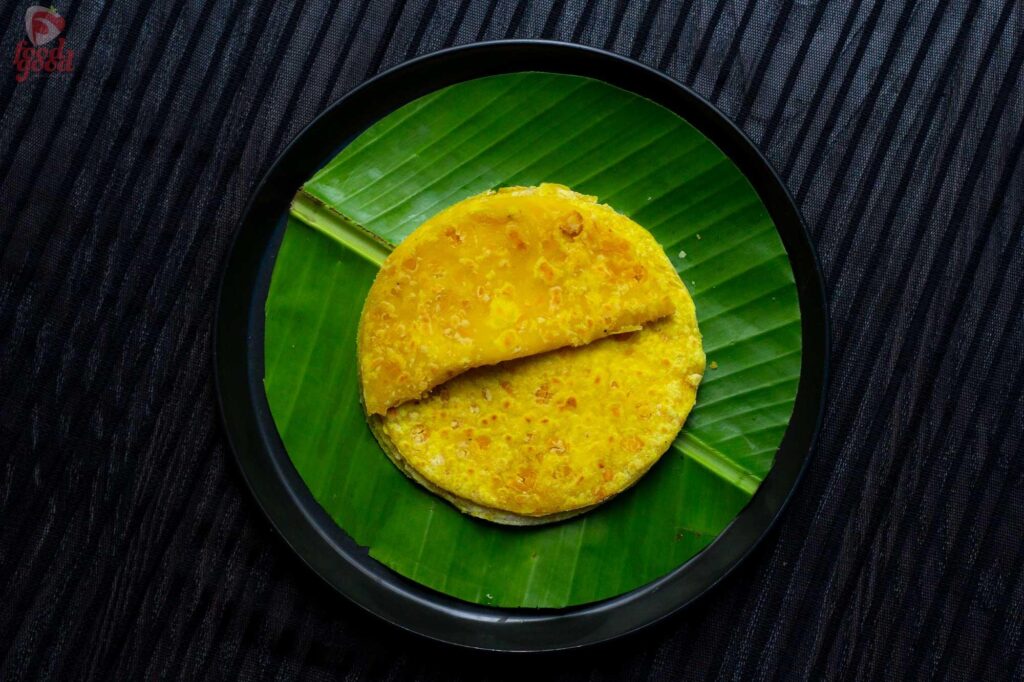Sweet Boli, with its soft, golden-yellow skin and sweet, melt-in-the-mouth filling, has quietly earned its place in the grand Kerala sadya. It may look delicate, but it carries generations of memory, culture, and movement within its thin folds.
Origin of Sweet Boli / Holige/ Puran Poli
Boli is not originally from Kerala. Its roots trace back to the Konkani-speaking Gowda Saraswatha Brahmin (GSB) community. As they migrated southwards over the centuries, they brought with them their food, language, and customs. Along with those came Puran Poli-a sweet flatbread made with a chana dal and jaggery filling, wrapped in a dough and gently roasted on a tawa. In Karnataka, it’s called Holige. In northern parts of Kerala like Kasaragod and Kannur, the same dish is still known by that name. But as it travelled further south, it softened in texture, brightened in colour, and became what we now call Boli.
In a typical Kerala sadya, Boli is served near the end of the meal, almost always paired with Palpayasam-the silky, slow-cooked rice and milk dessert. This pairing is not random. The slightly chewy sweetness of Boli and the gentle creaminess of Palpayasam create a simple but satisfying combination. Some fold the Boli and dip it into the payasam, while others pour a little over it. Either way, it’s a final touch to the sadya that lingers long after the banana leaf is cleared.
Making Boli is an art. The filling is made with cooked chana dal and jaggery, flavoured lightly with cardamom, and mashed until smooth. The outer layer-made from maida-is kneaded soft and stretchy. Each ball of filling is carefully wrapped in dough and rolled out thin, often using a banana leaf or plastic sheet to prevent sticking. It’s then roasted on a tawa with ghee until lightly golden.
In some homes, especially during festivals like Vishu or Navaratri, Boli is also made as a special prasadam. Its presence brings a quiet sense of celebration, a feeling that something good is being shared.
While the northern versions might be slightly thicker and less sweet, the southern Kerala Boli is paper-thin, sweet, and often has that unmistakable yellow hue from turmeric or food colour-a distinct local touch.
Boli may not shout for attention like payasam or parippu curry in a sadya, but its presence is steady, meaningful. It tells the story of movement, of adaptation, of how a dish can travel across borders and languages, and still find a place on our leaf.
Sweet Boli
Description
Boli is a popular traditional dessert of Kerala, especially served during a sadya alongside Pal Payasam. This sweet, thin, golden flatbread is filled with a delicious chana dal stuffing.
Ingredients
Instructions
-
Soak chana dal overnight. Drain the water.
-
Cook the dal with enough fresh water until soft but not mushy.
-
Drain excess water and grind the cooked dal into a smooth paste without adding any water.
-
In a pan, heat the dal paste with sugar. Stir continuously until it thickens. Add nutmeg powder or cardamom powder for flavor. Let it cool.
-
Make small lemon-sized balls from this sweet dal filling and keep them aside.
-
To prepare the outer dough, mix all-purpose flour (maida) with turmeric powder and enough water to make a soft and slightly sticky dough.
-
Add a tablespoon of gingelly oil (sesame oil) and knead the dough well until soft and pliable. Rest the dough for at least 30 minutes.
-
Divide the dough into small balls.
-
Take one flour dough ball, flatten it by hand or using fingers, and place one dal filling ball inside. Cover and seal it with the dough.
-
Dust a surface lightly with flour and gently roll the filled ball into a thin disc.
-
Heat a tawa or pan. Cook the Boli on both sides with a drizzle of ghee, until golden spots appear.
-
Sweet Boli is ready!
-
Serve warm with Pal Payasam or enjoy it as a snack with tea.


